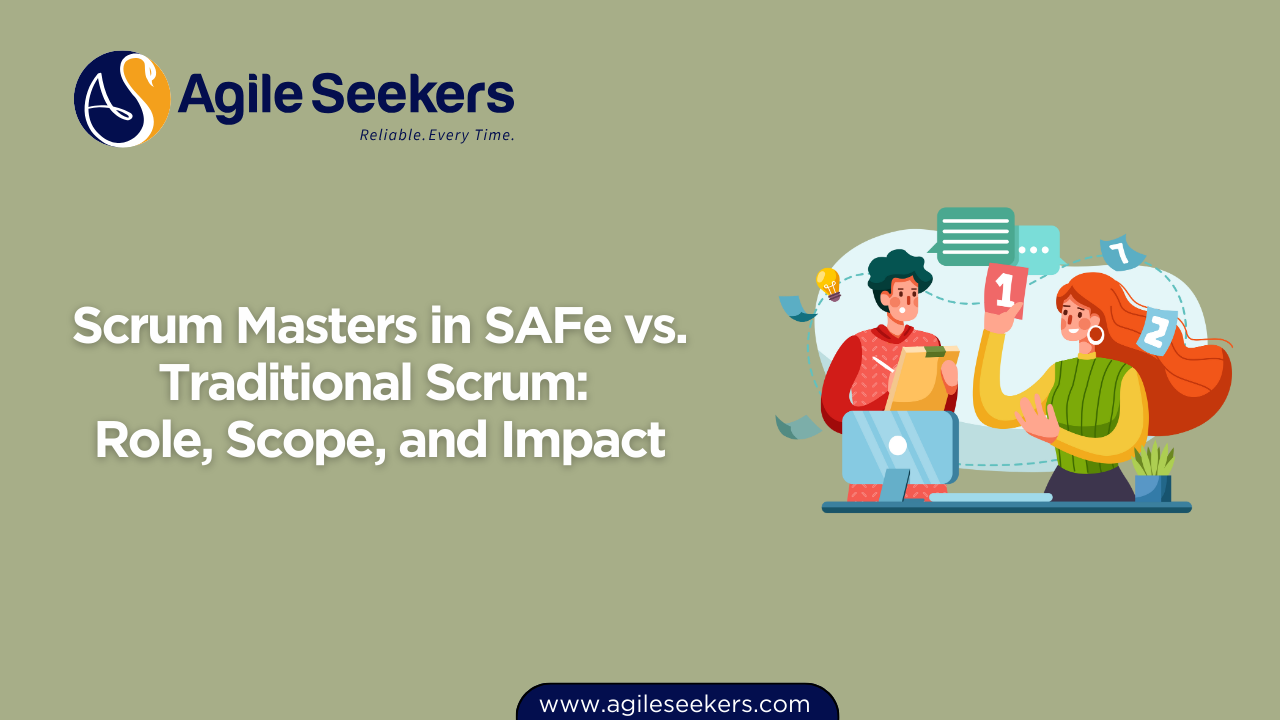SAFe Scrum Masters vs. Traditional Scrum Masters

Scrum Masters play a crucial role in helping teams stay Agile and continuously deliver value. But the definition of their role can shift significantly depending on whether they’re working within a traditional Scrum team or part of a scaled framework like SAFe. This post compares their responsibilities, scope, and organizational impact in both settings.
Core Responsibilities Shared by All Scrum Masters
Regardless of framework, every Scrum Master works toward:
- Facilitating Scrum events
- Supporting the Product Owner
- Removing team-level impediments
- Fostering continuous improvement
- Coaching team members on Agile values and principles
That said, how these responsibilities are applied differs between traditional Scrum and SAFe.
Traditional Scrum Master: Focused and Team-Oriented
In a traditional Scrum environment:
- Team-centric role: One Scrum Master typically supports a single Scrum team.
- Events facilitated: Daily Scrum, Sprint Planning, Reviews, and Retrospectives.
- Coaching limited to the team: Their reach typically ends at the team boundary.
- Tools used: Jira, Confluence, and team-level metrics.
This setup is ideal for smaller organizations or teams working on a single product.
If you're beginning your Scrum Master journey, enrolling in a Certified Scrum Master training course is a great place to start.
SAFe Scrum Master: Coordinating Across Teams
In the Scaled Agile Framework (SAFe), the Scrum Master operates at both the team and program level, with responsibilities extending beyond a single Scrum Team.
Key Differences in Role and Scope
| Area | Traditional Scrum Master | SAFe Scrum Master |
|---|---|---|
| Team Focus | One team | One or more teams within an Agile Release Train (ART) |
| Event Facilitation | Sprint ceremonies | Scrum events + PI Planning, Inspect & Adapt, ART Syncs |
| Impediment Resolution | Team-level | Program-level and inter-team issues |
| Stakeholder Engagement | Product Owner, team | RTEs, Architects, Product Management, and more |
| Coaching Focus | Scrum practices | Lean-Agile mindset, SAFe principles, cross-team collaboration |
SAFe Scrum Master Role Explained
- Program-Level Participation: SAFe Scrum Masters are active participants in PI Planning, Inspect & Adapt workshops, and Scrum of Scrums.
- Lean-Agile Mindset: They promote lean flow, systems thinking, and DevOps integration.
- Dependency Management: They help manage and resolve dependencies across multiple teams.
- Agile Coaching at Scale: Their coaching extends beyond the team to the entire Agile Release Train.
Professionals planning to work in large-scale Agile environments should consider enrolling in SAFe Scrum Master training to develop the necessary mindset and tools.
Role Comparison Table
| Aspect | Traditional Scrum Master | SAFe Scrum Master |
|---|---|---|
| Primary Focus | One Scrum Team | Team and ART Coordination |
| Events Facilitated | Daily Scrum, Sprint Planning, Review, Retrospective | Team Events + PI Planning, ART Syncs, Inspect & Adapt |
| Impediment Scope | Within team | Cross-team and program-level |
| Coaching Reach | Only team | Team + ART + System-level stakeholders |
| Training Needed | CSM certification | SAFe Scrum Master training |
Strategic Impact: Who Benefits More?
While both roles are essential, SAFe Scrum Masters often have a wider sphere of influence. Their decisions and facilitation support delivery across multiple teams. Meanwhile, traditional Scrum Masters can focus more deeply on team dynamics and technical practices.
The choice depends on your environment:
- In small to mid-size organizations, traditional CSM certification training is often sufficient.
- For enterprise-level Agile transformations, SAFe Scrum Master training builds the scale and system awareness required.
Career Paths: From Team Coach to Transformation Leader
Many Scrum Masters begin with CSM training and gradually move into scaled Agile roles as they gain experience. Those looking to elevate their career can:
- Support Agile Release Trains
- Become Release Train Engineers (RTEs)
- Specialize in SAFe coaching or Agile transformation
Investing in a combination of traditional and SAFe Scrum Master training opens doors to broader Agile leadership roles.
Useful Resources
Final Thoughts
The Scrum Master title means different things in different environments. Traditional Scrum Masters focus on team-level coaching, while SAFe Scrum Masters handle system-level flow and alignment. Both paths are valid—but they require different tools, perspectives, and training.
Whether you’re starting out or scaling up, getting the right education—such as Certified Scrum Master training or SAFe Scrum Master training—can be the key to success.
Also see - Helping Product Owners Build Better Backlogs
Also read - Running Multi-Team Scrum: Key Challenges and How Scrum Masters Can Solve Them




















